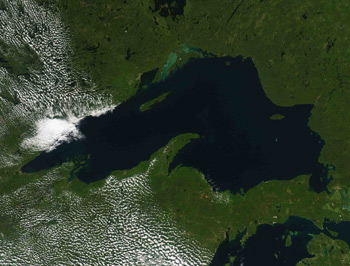
New Great Lakes temperature projections say Lake Superior will warm the most by 2100. Photo: NOAA CoastWatch
Jeff Gillies
jeffgillies@gmail.com
Great Lakes Echo
Sept. 28, 2009
Great Lakes climate science is often stuck in the past. Studies show that all five lakes have warmed up over the past century. But they rarely predict how much the water will warm in the next one.
A new tool from Canada could help buck that trend, warning policymakers of new threats from foreign organisms and other waterborne consequence of global climate change.
Scientists have already predicted how much the region’s air temperatures will rise, said Justin Trumpickas, former research technician with the Ontario Ministry of Natural Resources and co-creator of the new tool.
So he and colleagues Brian Shuter and Charles Minns built a mathematical model that turns those air temperature projections into Great Lakes water temperature projections. By 2070 to 2100, Lake Superior’s surface water temperature could jump by 8 to 12 degrees. Lake Erie’s could jump 4 to 6 degrees.
A simple method of predicting warming trends could be a boon to Great Lakes officials trying to anticipate the consequences of a warmer world.
“If management agencies are interested in looking at mitigating the effects of climate change on aquatic systems, you kind of have to have an idea of what sort of changes are going to be happening,” he said.
One of those changes could be an influx of invasive species, said Michael Jones, professor of fisheries and wildlife at Michigan State University.
“One of the reasons that a lot of fish haven’t invaded the Great Lakes yet is that they’re too cold,” he said. As the lakes warm up, more exotic and potentially harmful species could find the water more hospitable.
At the same time, warmer water could expand habitat and boost production of native species, Jones said. If warmer water spurs both native and invasive species into reproductive booms, it’s tough to guess what will happen.
“Those two things could interact in a way that’s pretty unpredictable,” he said
So any tool that clears up the murky future of climate change is a big help. Trumpickas’ model can do that, and should only get better with time.
The programs that climate scientists use to project air temperature increases are still clunky, but they’re getting better, Trumpickas said.
“As the climate projections become a bit more precise, we have a bit more confidence in them,” he said.
When climate scientists generate a new and improved set of air temperature projections, Trumpickas’ model would only take about a day to spit out a new set of Great Lakes water temperature predictions, he said.
A recent article in the Journal of Great Lakes Research describes the model.
Great Lakes Echo journalists report on the environment
Pingback: Scientists Predict Warmer Great Lakes Water Temperatures « Earth Environment Underground